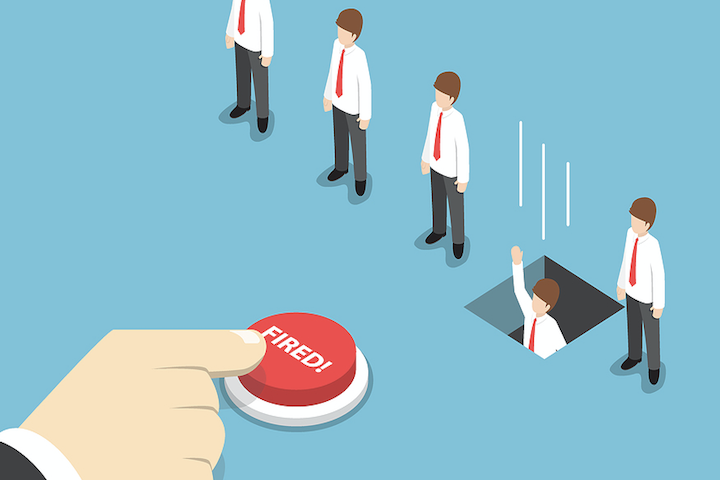Remote workers more likely to get laid off
Research by Live Data Technologies has revealed that remote workers were most likely to be laid off or miss out on promotion compared to their peers who worked permanently in the office, or in hybrid arrangements. It found that in 2023 fully remote white-collar workers were 35% more likely to get laid off than colleagues who put in at least some time in the office. The software development firm, which tracks job trends, also found that remote employees were 31% less likely to get promoted. But the data also reveals the potential legal risk companies are likely to be taking by pursuing such a move. “While remote work in and of itself is not a protected classification under federal and state civil rights laws, the reasons for that remote work could be,” said Lynn Vuketich Luther of Eastman & Smith Ltd. She added: “If an employee is working from home as an accommodation for a disability and they are passed over for a promotion or they’re let go because they’re not in person, then that could very well result in a discrimination claim. We have seen instances of that.” The data – which looked at more than 2 million records – follows a similar survey in December by ResumeBuilder.com, which said that employees’ work arrangements could impact their career advancement.
…as best jobs list for remote workers is revealed
According to new analysis of the Current Population Survey from the US Census Bureau and US Bureau of Labor Statistics, the ’15 Best Jobs for Remote Workers’ has been revealed – with these occupations, ranging from industrial psychologist, to web developer, lawyer, operations research analyst, statistician and marketing manager, all making the list. The number one job role was deemed to be a financial manager (demand for which is also predicted to rise by 16% between now and 2032), followed by software developer, IT manager, medical and health services manager, and information security analyst. Other top remote roles include data scientist, and actuary [the Bureau of Labor Statistics projects 23.2% employment growth for actuaries between 2022 and 2032]. Operations research analyst roles have a projected 10-year job growth rate of 22.5%, and command a median salary of $85,720. According to a 2022 survey from the American Bar Association, the vast majority of the nearly 2,000 ABA members surveyed (87%) said their workplace allows lawyers to work remotely, and about 30% of lawyers work from home almost all the time.
Restaurant worker ‘sacked’ over $10,000 tip

A restaurant worker from Michigan has reportedly been fired after a $10,000 tip (on just a $32 tab), created a dispute over who else the gratuity should be shared with. The server – Linsey Huff – was waiting on a table at the Mason Jar Cafe in the western Michigan community of Benton Harbor. After posting about her tip on social media, Huff’s co-workers then sought a cut of the gratuity, and the story has since evolved into her dismissal as well as threats to sue her because she discussed her firing on social media. An attorney – Jennifer McManus – has now got involved to represent Huff, who said: “The people with the money…control the narrative, and the people that work for them understand that and often have to cower because of that.” The restaurant diner originally paid for his $32.43 bill with an American Express credit card, and left a $10,000 tip to honor the memory of his dead friend, and asked Huff to share the gratuity with her waitstaff colleagues. As word of the 30,836% tip spread, and seven of Huff’s fellow servers split the gratuity evenly, each getting $1,200, kitchen staffers felt unjustly left out of the windfall became upset, according to McManus.
Cloud company pays staff to socialize with each other
This week it was revealed that cloud-based security company, Verkada, is paying staff to socialize with each other after 3pm. The perk was discovered after a post by Verkada’s CEO Filip Kaliszan, went viral on TikTok. The so-called 3-3-3 benefit lets employees expense up to $30 in food and drinks if they go out, in groups of at least three after 3pm. ”The idea is that it’s the afternoon and if three people go out and hang out together, chances are they’ll talk about something relevant or work-related, and ultimately that will benefit us,” Mr Kaliszan said. According to Business Insider, all1,800 of Verkada’s employees have participated in the program at least once. The program requires no pre-approval, but employees are required to post a photo in the “3-3-3” Slack channel when they’re done with their outing. Before the program was officially launched last year, employees could go for drinks at the expense of the company, but they didn’t know about it. So, the firm decided to promote it better, by advertising the program on posters around the office and in elevators. “It wasn’t about the money and it wasn’t about the budget. It was about everyone knowing that this is something they can do and then everyone getting excited about it,” Mr Kaliszan added.
OpenAI to let staff sell shares at $86 billion valuation
Artificial intelligence start-up, Open AI, has reportedly completed a deal allowing employees to sell shares in the company – which will value the company at a whopping $86 billion. The valuation means the AI company’s worth has tripled in value in less than 10 months. The share sale option now allows members of staff to cash-out their shares. The share sale was previously set for last year, but was delayed following the OpenAI board’s ousting of CEO, Sam Altman, in November. The company has since rehired Altman and is in the process of appointing a new board of directors. In addition to the tender offer, OpenAI has also discussed raising new funding that could put the company at the even loftier valuation of more than $100 billion. OpenAI has been at the heart of the AI boom since the release of its ChatGPT chatbot in November 2022 thrust it into the limelight. The firm, which Sam Altman leads, saw its revenues soar to more than $1.6 billion in 2023, due to an explosion of interest in the tech.
Poor air quality will be serious problem by 2050s
The number of working days globally lost to poor air quality is predicted to more than triple to 3.8 billion days by 2060, according to latest research. According to analysis of pollution exposed to US job-holders by Quartz, the American labor force will lose an estimated $334.1 billion in 2054 alone – which is more than double the loss workers already suffer every year as a direct result of bad air quality ($125 billion). The research was based on estimated levels of particulate matter 2.5 (PM2.5), which is the primary pollutant in wildfire smoke. With PM2.5 pollution (in micrograms per cubic meter of air) predicted to rise 8% to an average annual concentration of 21.5 µg/m3, this is enough to create the alarming cost to employee finances. “Understanding the likelihood and persistence of poor air quality exposure is important due to the well documented impacts on health outdoor labor productivity, and the nuisance of smoke impacting daily routines,” said Jeremy Porter, First Street’s head of climate implications research. “We are just starting to see the beginnings of the impact this hazard will have on our daily lives and the larger economy moving forward.” In western US, PM2.5 pollution could increase as much as 50%. Between 2013 and 2022 data shows an average of 61,410 US wildfires occurred every year between, with this figure set to increase by 30%.
Gen Z more likely to want to re-skill
Despite being the generation that has grown up with technology (and most likely knows what to do with it better than any other cohort), it’s Gen Zers that are the most likely to want to re-skill, according to new research. Around 41% of the Gen Z workforce say they plan to attend physical classes to learn new skills – which is a higher percentage than both Gen X and baby boomers, according to LinkedIn’s latest Workforce Confidence survey. “It’s possible many Gen Z professionals may be attracted to in-person learning because they didn’t previously get that full experience during the pandemic,” said Dan Brodnitz, global head of content strategy for LinkedIn Learning Brodnitz. He adds that an inclination towards in-person classroom learning is consistent with Gen Z’s work preferences, as they gravitate towards hybrid and in-person schedules more than older coworkers: “They crave in-person interaction, likely because they are new to work and still building their networks,” he says. The data also found around 59% of Gen Z employees plan to up-skill virtually, compared to 65% of millennials and 60% of Gen Xers.
